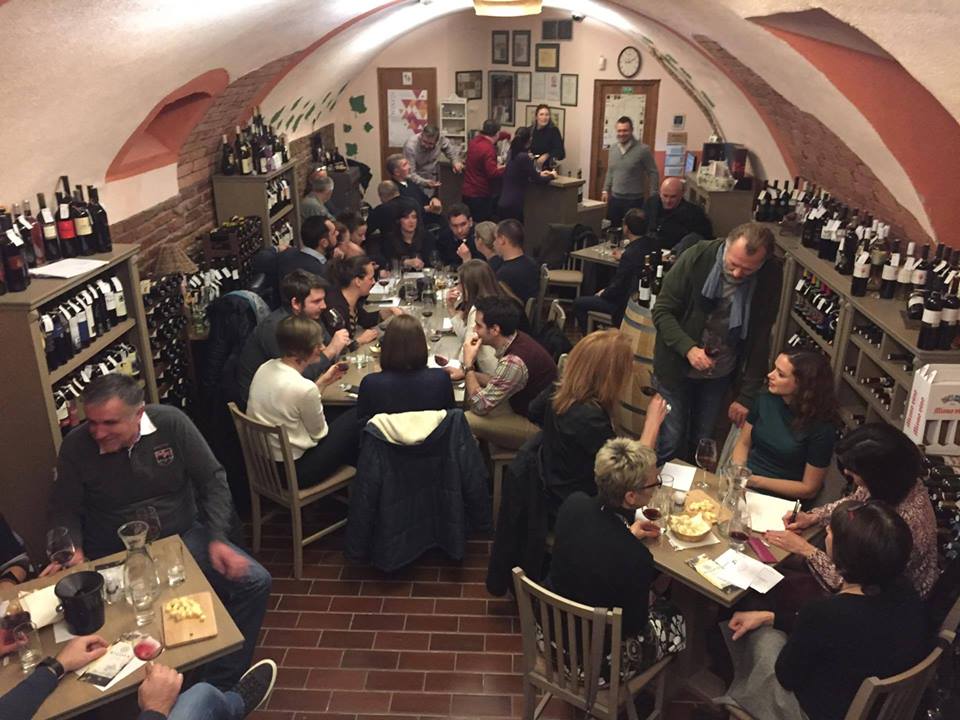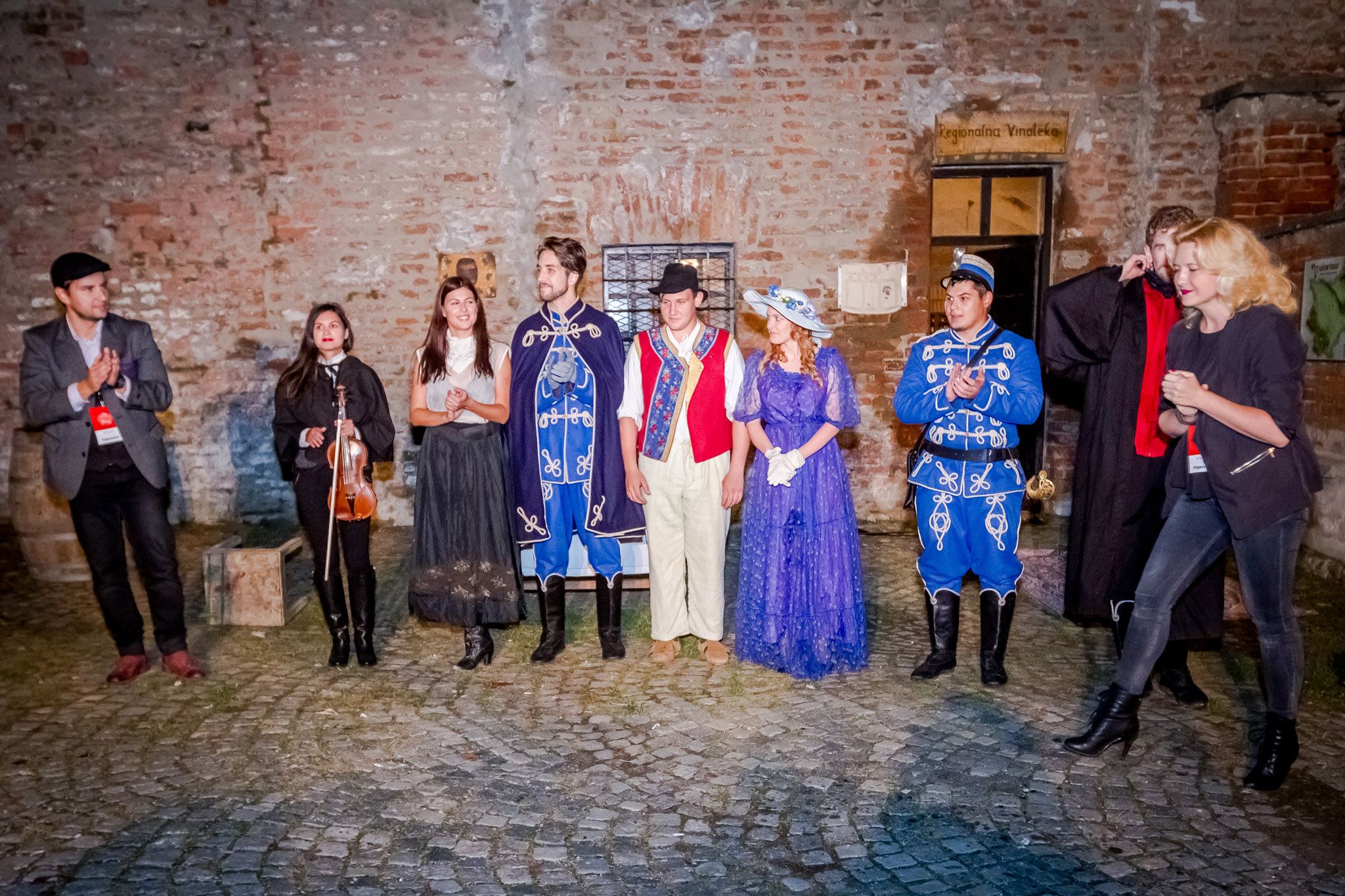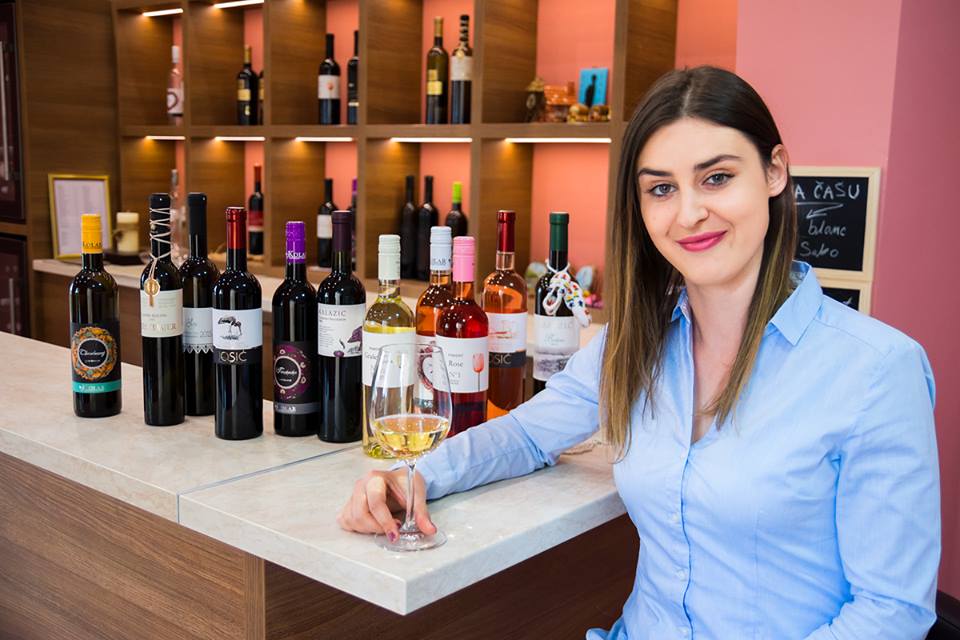The following is a story of two wine bars in eastern Croatia. One is in Slavonia, the other in Baranja, one along the Drava River, the other next to the Danube River
Where to drink a quality wine in Slavonia and Baranja if you don’t have the time to tour wine cellars or refrain from buying wine in shopping centres, and you would like more refined wines than those found in caffe bars, used primarily for mixing? And what is the best way to go from one wine bar to the next, and what can you see and experience along the way?
First of all, wine cellars are tougher to get to. They are found beyond larger urban centres, with mostly winding roads and hills, and once you get to a cellar, one glass of wine will not be enough. Tastings usually begin with Graševina, then a few white varieties, sometimes a rose, then on to red varieties, followed by a late harvest wine. After that you should consider yourself lucky if the winery has accommodation to offer! Or would you like to find out how strict the police are and how comfortable the bed is in the nearest lockup?
Buying wine in supermarkets is a story of its own! How many times have you bought a wine on sale, and after tasting it found it was not what you expected it to be. In the worst case it may have even gone bad. Temperature and light in supermarkets are simply not ideal conditions for storing wine. So if the wine is not last year’s harvest and is on sale, you can be sure it is only because the supermarket is looking to get rid of it soon.
The following is a story of two wine bars in eastern Croatia. One is in Slavonia, the other in Baranja, one along the Drava River, the other next to the Danube River. The first is in an urban setting, right along the main Osijek square, the other in the countryside, alongside vineyards.
Both wine bars are connected via the Pannonian Road of Peace, a unique cycling route connecting the Drava with Danube, crossing through Kopački Rit Nature Park and picturesque Baranja villages. Since bike&wine is becoming a more popular concept, I recommend you visit both bars in the same day by bike and compare the Pannonic variations of Slavonia and Baranja, Danube and Drava. Owners of both bars are women and this is proof, along with winemakers Kristina Pinkert, Julijana Seleši Novački, sisters Sibila and Kinga Kolar and director of the Zmajevac winery Gabriella Gerštmajer that the wine business is not reserved only for men.
Naturally, when the affirmation of women in wine is the topic, we need to mention an association based in Zagreb, with members all over Croatia: WOW – Women on Wine, which recently toured Baranja. Members of the gentler gender in WOW produce wine, are in marketing, distribution and sales of wine, work in wine shops, study wines, create new wines and write about them.
The association was founded and is currently presided by journalist Sanja Muzaferija. Her idea in founding the association was to organise the female presence on the wine scene, but also the vision of creating a networking platform whose primary goal and mission is to publicly announce that Croatia has a strong female wine scene, while also connecting women who in any way deal with wine.
WINE STORE AND WINE BAR VINITA
When you wish to treat your palate with a glass of wine in Osijek, all roads will lead to Vinita. It sits in the Josip Juraj Strossmayer Street, right along the main Osijek square. The wine store was founded in 2011 by spouses Tanja and Vinko Ručević. In the past four years Vinita managed to fulfil what their owners wanted – to create a programme of various content to attract and educate citizens, promoting and elevating the table culture to a higher level, as well as the wine culture.
The rustic style, with pronounced red brick walls and wooden furniture, turns Vinita into a small time machine giving visitors the sense of times past, along with a glass of good wine. What brings guests back to Vinita is a simple domestic charm which turns all who are present momentarily into passionate wine lovers.

The rich rhapsody of tastes comes from a wide selection of superior wines from all Croatian Regions, including many domestic winemakers which cannot be found in supermarkets, but also many from abroad. The wine chart of Vinita has 350 labels from around the world, which is why the place is said to have the largest and widest selection of wine found in one space.
The charming ambience of the Vinita cellar saw many guided tastings and eno-gastronomic education, as well as tastings of combined food and wine, managing to always attract a colourful range of visitors – from top-notch sommeliers to occasional consumers of this noble drink.
Vinita has a habit of hosting and presenting many domestic winemakers and their wines, but its refined taste is not limited to the borders of Croatia – Vinita can boast of hosting winemakers from all of Slavonia, Baranja and western Srijem, Istria, Dalmatia, Herzegovina and all the way to France. Besides guest presentations, the rich programme is filled with various creative events tied to wine, such as an amateur blind wine tasting Best Palate, meant for all enthusiasts and wine lovers.
The wonderful ambience and positive vibrations of this wine store resulted in the first Osijek wine festival WINEOS sprouting here, held for the first time in 2014 in the Slavonia Museum, with the next edition in December of 2017. Regarding the festival Tanja Ručević noted:
“The festival combined presentations, seminars and educational workshops for business people, traders, sommeliers, caterers, journalists and public personas and offered tastings of wine and various delicacies for all lovers of wine and gastronomy, thus providing visitors with an opportunity to learn a range of details from the eno-gastro vault of tastes and knowledge. WINEOS has for the first time given Osijek a festival completely devoted to table culture, wine and food, as well as the unavoidable economic element and tourism offer.”
The quality offer of urban content has made this wine store a favourite meeting point of Osijek wine lovers, so when in the area don’t hesitate to treat your palate in Vinita.
OSIJEK AS THE CENTRE POINT OF THE WINE QUADRANGLE
The general perception of the wider Osijek area is one of a never-ending flat land; gigantic wheat, corn and sunflower fields. But according to the Viticulture Registry, the Osijek-Baranja County has the largest production of wine in the state; it is the only county in Croatia where over 100 thousand hectolitres of wine are produced annually. The county has four wine growing regions, with Osijek in the middle of them. West of Osijek comes the Feričanci wine region, south is the Đakovo region, east is the Erdut region and north is the Baranja region. All four of them are 30-40 kilometres away. As part of the wine tour project, a wine store was created in each of the regions and a regional wine store in the Osijek Tvrđa fortress – next to the recently renovated Water Gates. Nor are Ilok and the Golden Valley too far from Osijek, nor the Hungarian Vilánny, one of their most famous wine regions.
The oldest name of modern day Holy Trinity Square in the Tvrđa – historical core of Osijek, is Wine Square. Wine was brought there each Wednesday and Saturday, and sold to caterers and soldiers. There is a living history theatre show Wine Square in which the audience interacts with actors to learn historical facts, more or less known stories and legends from the historical layers of the Tvrđa. What makes these walks through Tvrđa special are various costumed historical and fictional characters interacting with the audience in an innovative and picturesque way, recounting the history of the land and acting out scenes from the life of the Tvrđa, connected to specific locations, guaranteeing a new experience of the historical urban core of Osijek town.

Wine Square show. Photo by Dražen Lazić
The Baroness Paulina von Hermann leads the audience through the show, which ends in the regional wine store by the Water Gates.
The show is performed in the production of the Croatian Cultural Tourism Society – CROCULTOUR. The script was made by Siniša Kovač and production by Jesenka Ricl, society President.
The Wine Square show is part of the interactive project “Forgotten Tvrđa,” which promotes historical facts and the material and immaterial cultural heritage of the Osijek Tvrđa through theatrical and tourism shows.
The aim of the project is to develop a competitive and quality theatre-tourism offer through the realisation of innovative solutions, promotion of tradition and rich cultural heritage of Osijek town, its identity and diversity.
The project is based on historical facts, familiar town stories and lesser known legends from Tvrđa. At the formal level the project is multidisciplinary, bordering between a touristic tour and performance art, using interactive strategies of communication with the audience.
Another interesting fact is that Osijek once had vineyards in the centre of town, owned by the Franciscan convent. They produced wine for liturgical needs, cut down in the 1960s during a wave of Osijek urbanisation.
PANNONIAN ROAD OF PEACE
Osijek and Batina, Drava and Danube, Vinita and Barrique are connected not only by the standard state road, but also with a cycling-walking path Pannonian Road of Peace. The route starts from Osijek to Bilj and Kopačevo, the entrance to Kopački Rit Nature Park, a village where most residents used to be professional fishermen, also known by the Fishing Days manifestation. Then come the pustare (open spaces) Podunavlje, Kozjak, Sokolovac and Mirkovac. These were specific work-social communities with numerous planned economic and social functions. In their golden age, pustare were a model example of how to combine production, accommodation and management. After the pustare the road heads to Suza village beneath Banovo hill. From Suza to Zmajevac – the wine capital of Baranja, the Pannonian Road of Peace leads to Batina.
There is an alternative route where after the Kozjak pustara the road goes left to Zlatna Greda pustara, where the first adrenaline park in eastern Croatia is found, moving along on a gravel road, the Danube embankment, alongside Gornja Siga Island, lately known as Liberland, to the asphalt road to Batina. Gornja Siga is a Serbian island on the Croatian side of the Danube, while Liberland is a source of much controversy. For some it is an attack on Croatian state sovereignty, for others a great story with tourism potential such as the British Principality of Sealand or Fristaden Christiania in Copenhagen. This alternative route is somewhat more demanding, but also more attractive. Hundred-year-old forests, flood fields which change their appearance by the water level of the rivers, rare and protected birds…
There is also an option for the section from Bilj to Kozjak to go through Vardarac and Lug. In Lug is the same name hotel which fosters the bike&wine concept. It is a regular host of a recreational bike ride organised by the recreational cycling association Kotrljaneri from Osijek, with its own wine cellar.
Kopački Rit is a confluence of the Danube and Drava rivers and is the largest flood area in this part of Europe. The image of Kopački Rit changes constantly due to the flood system. Every new flood form Danube and Drava waters changes this unique eco system.
From Osijek to Batina, from Drava to Danube, riding my bike along the vast swamp scenery I met Goran Šafarek, explorer, writer, biologist, photographer and videographer. Goran is the author of hundreds of articles, several films and books devoted to the flora and fauna worlds. He took part in scientific exploration expeditions on Galapagos, Borneo, Sri Lanka, Madagascar etc. He says the beauty of the Croatian flora and fauna is not less attractive than some exotic destinations. Goran wrote the book Rivers of Croatia, recently starting a crowdfunding campaign to film the same name documentary! We wish him luck in completing that project as people around the world will experience the beauty of Croatian rivers, beauty in which we locals can enjoy directly by riding kayaks and canoes on the river, pond, swamp or walking and cycling alongside them!
I also met the team from the Regional Development Agency of Slavonia and Baranja, Ekotour association and civic initiative “Stop Demolishing Old Baranja,” searching together with Hungarian partners for an ideal location to hold a pustara festival. Pustare are a unique example of Pannonian industrial heritage in the rural ambience and if something is not done soon they will be torn down and remaining inhabitants evacuated. Some 15 pustare existed once, each the seat of a management unit, connected with a narrow railroad from Zeleno Polje at the current border with Hungary to the Kazuk port on the Danube.
WINE BAR BARRIQUE
In my wanderings, the constant searching for a perfect hedonistic pleasure, I have toured many restaurants, bars, excursion sites, but the title of the destination with the best view (at least in Croatian Pannonia) definitely belongs to the wine bar Barrique.
Barrique is nestled alongside the monumental memorial “Victory” by sculptor Antun Augustinčić, devoted to the Batina battle.
The terrace of the wine bar Barrique offers a phenomenal view of Bačka in Vojvodina (northern Serbian region) and Hungarian counties Bács-Kiskun and Baranya. The Croatian bank of the Danube is significantly higher than the Vojvodina side, so the place always had strategic value. During Roman times the Ad Militare fort was here, used to control invading barbarians. During the end of the Second World War the notable Batina battle took place here where the Germans, helped by the strategically elevated position resisted for days the onslaught of Soviet soldiers (mainly Ukrainians) in whose honour the “Victory” monument was erected.

Marina Šašlin, owner of wine bar Barrique. Photo by Zvonimir Janković
Across from wine bar Barrique is the Batina Battle Museum and the Tourism Board of Draž District. Barrique is present at this location seasonally for three years, opening sooner and closing later each season, with a tendency to work year-round.
From the Batina village, where recently a cruiser dock was opened, the only Baranja settlement on the Danube itself, Barrique is two kilometres away, and to reach it you need to pass endless vineyards.
Barrique offers exclusively Baranja wines. From Batina wines (Kalazić, Kočevar) to wines from Zmajevac, Suza, Kamenac, Kneževi Vinogradi etc.
Everything revolves around wine here. Before the wine bar opened, there stood the Kalazić wine store and while I spoke with owner Marina Šašlin our conversation was joined by Zagreb employees of the revision company supervising the usage of EU funds, currently visiting wineries Pinkert in Suza and Kronos in Batina.
Marina did not step in the path of most youth looking to escape the area, after completing Tourism Management studies near Opatija and working at the Zagreb Faculty of Economics, she returned to Batina and opened Barrique.
“Although it is currently facing drastic depopulation, I see great potential in Baranja. This is not only irrational local patriotism, but a realistic assessment. Everyone told me in the beginning I was crazy to return to Baranja, considering I could hold a job as a hotel manager on the Adriatic coast. With Barrique in its third year they look at me with envy. There is potential, but sailing entrepreneurial waters takes courage. On less than 1.150 square kilometres there are nine wine roads here. In neighbouring Zmajevac there are over twenty winemakers. Without false modesty, Baranja has huge potential! We can make miracles here. But we all have to stick together! There needs to be a synergy of winemakers, family farms, caterers, local administration and tourism boards. Whoever comes to me with a positive idea, event suggestion, festival, is welcome. I am unburdened with prejudices and cooperate with anyone who has a quality idea. The mission of wine bar Barrique is to present and offer visitors wines of interested Baranja winemakers in one place which breathes peace, silence, a place offering visitors a contemplative view and nestled between vineyards and Danube. The role of the Danube is well known. The Danube brings soil which is a precondition for successful viticulture in the area. My family is in hunting tourism and also wine production, in smaller quantities and for personal use, so I also hold the wine growing tradition. I envisioned the interior design myself, everything renowned designers presented did not impress me too much.”
Wine bar Barrique also promotes the bike&wine concept. Last year at the end of August, organised by the informal civic initiative Liberas, the Liberty Fest took place which had educational, entertainment and sports recreation components. There was also a cycling event held under the motto “Discover the hidden lure (draž) of Baranja” (Batina is located in Draž District), whose route traced vineyards on the slopes of Banovo hill, with the start and finish outside wine bar Barrique.
Marina says she is also sometimes a tour guide, informer, interpreter and educator.
“When someone wants to see the memorial museum outside opening hours, I open it up and tell them the story, trying to offer all the information they may find useful and necessary.”
They are also regular participants at the Gator Fest to be held this year on 9 and 10 June. The first day of the festival Barrique will host a jazz concert and probably a wine presentation. Soon to come is a painting exhibition of academic painter Nevena Živić, with Baranja souvenirs to be offered as most guests come from outside Baranja, whether passing through or visiting Osijek and Baranja.


